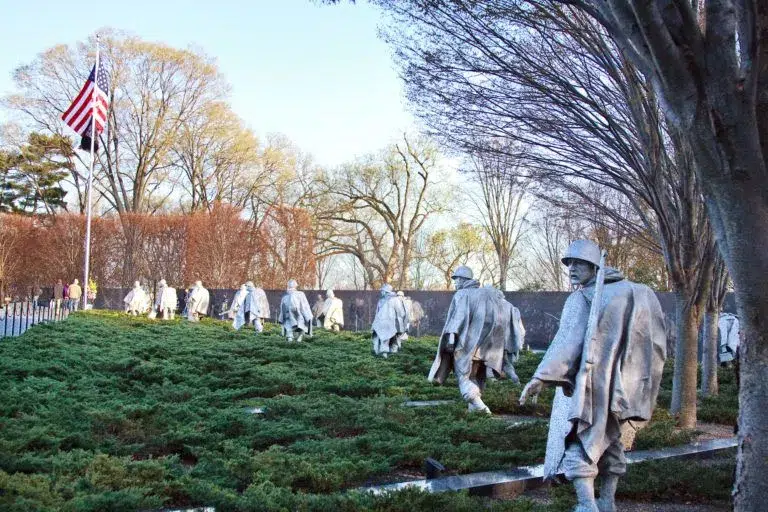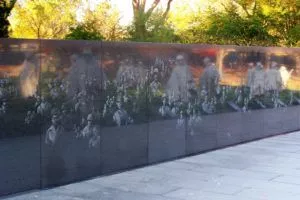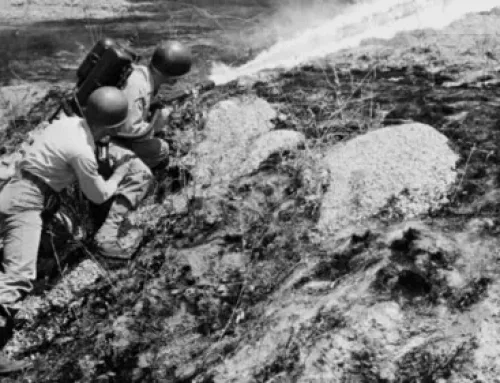The Korean War Veterans Memorial
The United States, as part of a UN coalition, assisted South Korea in the three year Korean War that began on June 25, 1950. During these three years, 5.8 million Americans were in service and 54,246 Americans died in action. Of these, 8,200 were listed as either missing in action or buried at sea. Additionally, between June 25, 1950 and July 27, 1953, 103,284 were wounded in the conflict. While the US was flourishing with post World War II peace, it became easy to forget that a war was raging oceans away, leading to the Korean War being the “Unknown War” or the “Forgotten War”.
With long overdue recognition, those who served during the Korean War were honored with the building of the Korean War Veterans Memorial. On October 28, 1986, the Korean War Veterans Memorial was authorized to be built by the American Battle Monuments Commission through the U.S. Congress. In September of 1988, President Ronald Reagan set the location of the memorial to be in West Potomac Park of Washington D.C. The design of the memorial was selected during a nationwide competition with more than 500 submissions. The winning design was submitted by cooperating designers known as the Cooper-Lecky Architects. President George H. W. Bush presided over the event to break the ground on Flag Day, June 14, 1992. The memorial was officially dedicated to those who served during the conflict on the 42nd anniversary of the end of the Korean War, on July 27, 1995. The Korean War Memorial appears as a circle intersecting a triangle, and includes various structures to honor US servicemen who served worldwide during the Korean War.
One of the most prominent attributes of the Korean War Memorial is the black granite mural wall, consisting of 41 panels and extending 164 feet, created by Louis Nelson. The mural wall has more than 2,500 photographic images taken of soldiers, sailors, marines, and airmen who fought in the conflict. The photographs are computer-enhanced and are also arranged to give a wavy appearance in harmony with the layout of the nearby statues. When viewed from a distance, the wall gives the appearance of the mountain ranges of Korea. The words “Freedom Is Not Free” is inscribed and inlaid in silver one of the Granite walls, serving as a reminder of the price of war.
The 164 foot long and 8 inch thick memorial walls are made of more than 100 tons of “Academy Black” granite from California. The granite walls form a triangle and point to the American flag, where the memorial’s dedication stone rests. The statement “Our nation honors her sons and daughters who answered the call to defend a country they never knew and a people they never met” is inscribed on the dedication stone at the point of the triangle leading to the American flag.
Within the walled triangle are 19 stainless steel statues, weighing nearly 1,000 pounds each, designed by Vermont sculptor Frank Gaylord. The statues represent soldiers on patrol facing an American flag, with fourteen figures from the U.S. Army, three from the Marine Corps, one Navy Corpsman, and one Air Force Forward Air Observer. In 1948, President Harry S. Truman signed Executive Order 9981, officially integrating the U.S Armed Forces. Therefore, because the Korean War was the first war with a fully integrated U.S military, the 19 statues depict the ethnic cross section of America by representing 12 Caucasians, 3 African Americans, 2 Hispanics, 1 Asian, and 1 Native American. The figures are in full combat gear, and wear ponchos over their weapons and equipment, signifying the cold winds of Korea.
The triangle points to and intersects at the circle form of the memorial, which is a 128 ft diameter shallow pool of water known as the “the Pool of Remembrance”. In the pool is a small waterfall, with a walkway along the perimeter as well as seven benches for visitors to sit and reflect on the sacrifices and importance of the Korean War. Along the walkway of the “Pool of Remembrance” are plaques inscribed with the number of American and United Nation soldiers killed, wounded, missing in action, and held as prisoners of war.




